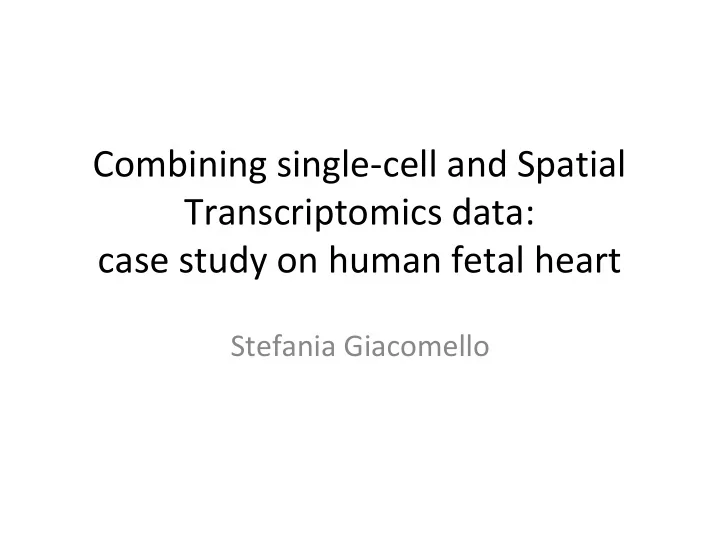

Combining single-cell and Spatial Transcriptomics data: case study on human fetal heart Stefania Giacomello
Why do we need spatial resolution? Understanding how cell localization in the tissue influences gene expression How adjacent regions in tissues interact at gene expression level Cell fate decided by several morphogens whose gradients originate from different regions of the embryo
How do we achieve spatial resolution? § Computational methods § Spatial Transcriptomics (FISSEQ, ISS) § Example on human fetal heart
Computational approaches
Seurat § Applied to zebrafish embryo § Seurat combines cells’ gene expression profiles (scRNA-seq) with a set of ‘landmark’ genes ( in situ hybridization) to guide spatial assignment
Seurat § 47 ISH genes § 128 bins (64 L-R symmetry) ~40–120 cells per bin, from in situ expression domain § 851 single cells
Seurat § 47 ISH genes § 128 bins (each ~40–120 cells), based on in situ expression domain à 64 bins due to left-right symmetry § 851 single cells (no cells with less than 2000 genes)
Seurat – pros & cons § Bins could be reduced to the single-cell level (each cell in each position has a distinct and reproducible gene expression identity and position) § Seurat relies on the spatial segregation of gene expression patterns to construct a reference map à tissues such tumors (no guarantee of reproducible spatial patterning), or tissues where cells have highly similar expression patterns and are spatially scattered across a tissue (i.e. adult retina)?
DistMap § Reconstruct the embryo and to predict spatial gene expression approaching single-cell resolution § Seurat was not giving enough resolution à obtained 87% of cells in the embryo are confidently resolved and depth (>8000 genes/cell)
DistMap § in situ hybridization data for 84 genes, resulting in a quantitative high-resolution gene expression reference atlas with substantial combinatorial complexity
DistMap
DistMap – pros & cons § Bins are very small and the number of genes detected is high § Spatial segregation of gene expression patterns to construct a reference map
Wet lab approaches
Spatial Transcriptomics
Spatial Transcriptomics 2D gene expression map of a tissue section Study functional and developmental aspects
The concept
The concept 6.2 mm 3’ polyT region UMI Spatial barcode spot-specific 6.6 mm ID from 1 to 1007 1007 spots in total Amplification + sequencing handle 100 µm diameter ~200 M oligonucleotides 5’ Cleavage site
The method Cryosectioning Staining High resolution imaging
The method Permeabilization Poly-T capture of transcripts On surface cDNA synthesis Tissue removal and release
The method Illumina sequencing Alignment and sorting of barcodes Alignment of image and barcoded transcripts
Proof of concept – later diffusion? Vertical diffusion Horizontal diffusion Permeabilization Hybridization Fluorescent cDNA synthesis Tissue removal Fluorescent print of the tissue morphology
Proof of concept – no later diffusion
Recommend
More recommend